RFID (Radio Frequency Identification) tags have been widely used for product authentication, but they have several drawbacks including size, cost, and susceptibility to counterfeiting. To overcome these limitations, a team of MIT engineers has developed a new type of ID tag utilizing terahertz waves, which are smaller, faster, and offer enhanced security features compared to radio waves.
The new cryptographic chip is significantly smaller and cheaper than RFID tags, offering improved security by leveraging the unique pattern of metal particles in the glue attaching the tag to the item as a fingerprint. This prevents tampering, as attempts to remove and reattach the tag to a fake item are detected through an antitampering feature utilizing terahertz waves.
Terahertz waves, electromagnetic waves between microwaves and infrared light, offer advantages such as higher bandwidth, resolution, and penetration capabilities through materials like clothing, paper, and plastic. The tag’s design incorporates tiny slots allowing terahertz waves to pass through, interacting with metal particles in the glue layer. The reflected terahertz pattern is then converted into a digital fingerprint for authentication against a database of registered fingerprints.
To prevent tampering, the antitampering feature destroys the glue layer upon removal, altering the metal particles’ pattern and corresponding terahertz signal. Multiple slots on the chip capture detailed information, making duplication impossible if the glue interface is compromised. Vendors can store initial tag readings in the cloud for verification.
However, precise measurement of glue patterns for authentication posed a challenge. This was addressed by employing AI, with a machine-learning model achieving over 99% accuracy in comparing glue patterns. Despite a limited data sample, improvements are possible with larger deployments.
“One drawback is that we had a limited data sample for this demonstration, but we could improve the neural network in the future if a large number of these tags were deployed in a supply chain, giving us a lot more data samples,” said Eunseok Lee, an electrical engineering and computer science (EECS) graduate student and lead author of a paper on the antitampering tag..
Terahertz waves face challenges such as high transmission loss, limiting the sensor’s distance from the tag to about 4 centimeters and requiring a sensor-to-tag angle of less than 10 degrees for accurate readings. Future work aims to address these limitations and expand the application of terahertz waves beyond broadband wireless, highlighting their potential for ID, security, and authentication.
In conclusion, the development of terahertz-based ID tags offers a promising solution to the limitations of traditional RFID tags. With enhanced security features and potential applications beyond current capabilities, terahertz technology represents a significant advancement in product authentication and security systems.

